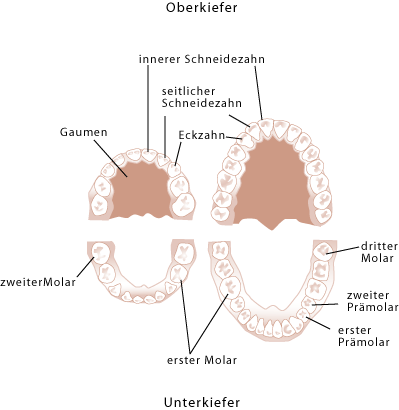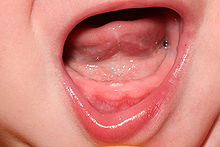Milk teeth
The man and many mammals form throughout life first a primary dentition of ( milk tooth: dens deciduus, from lat. : Dens 'tooth' and decidere 'fall off' here: 'fail') that during growth by a permanent, bite is replaced .
Deciduous teeth in humans
The milk teeth are the only “organ” that the body completely renews and replaces once. A temporary set of teeth is important for development because there is not much space in the small jaw of a baby or toddler. The growth of the jaw causes the milk teeth to move apart and the result is gaps in the teeth. The milk teeth are gradually replaced by the permanent teeth. Its teeth are larger and wider, so that a homogeneous, closed row of teeth is created again.
A child 's deciduous dentition consists of 20 teeth , with five teeth per quadrant : the central and lateral incisors , the canine, and the first and second deciduous teeth . (The dentition is divided into four quadrants: one right and one left quadrant, each in the upper and lower jaw.)
The name is explained on the one hand by the bluish-white color of the milk teeth (i.e., they are colored milk-like in contrast to the more yellowish permanent set of teeth), on the other hand by the typical diet with breast milk in the first phase of life.
Teething (1st dentition)
Growing out (“breaking through”, dentition ) of the teeth is often painful for the child. It usually happens in the following order: First, around 6 to 8 months of age, the central lower incisors erupt.
The table shows the average eruption times of the milk teeth :
For the tooth designation see: Tooth scheme
| No. | Milk tooth | OK teeth | Lower jaw teeth | Month of life |
|---|---|---|---|---|
| 1. | Central incisor | 51, 61 | 71, 81 | 6th - 8th |
| 2. | Lateral incisor | 52, 62 | 72, 82 | 8th - 12th |
| 3. | 1. Deciduous molar | 54, 64 | 74, 84 | 12-16 |
| 4th | canine | 53, 63 | 73, 83 | 16. - 20. |
| 5. | 2. Deciduous molar | 55, 65 | 75, 85 | 20th - 30th |
OK = upper jaw; Lower jaw = lower jaw
The upper antagonists (opposing teeth) usually erupt some time after the corresponding lower teeth.
The time of the eruption is very variable, so the first incisor can appear in the fourth month, but also much later. The eruption of the other teeth is then shifted accordingly.
On average, by the age of 30, all milk teeth have erupted and are fully toothed by the end of the age of 3, so that the tooth crowns are in contact with the respective opposing tooth . The root growth is not yet complete at this point and will take another 1 to 2 years. From the age of 3 the period of use of the deciduous teeth begins , which lasts until the teeth change.
In very rare cases, baby teeth have already erupted at birth, so-called dentes connati (singular: dens connatus , from Latin : dens 'tooth' and connatus 'innate'), popularly also called witch's teeth. Prominent examples are said to have been the French Sun King Louis XIV and Sisi .
The milk teeth have tooth roots just like the permanent teeth . The deciduous incisors and canines have one root, the deciduous molars have two roots in the lower jaw and three roots in the upper jaw. Anomalies are very rare in primary dentition. When changing teeth with the resulting normal loss of milk teeth, the roots of the milk teeth are resorbed (dissolved) by the permanent teeth that push in ; the milk teeth seem to have no roots.

Grinding teeth
In the course of natural skull growth, childish (mostly nocturnal) teeth grinding ( bruxism ) is normal and useful, even if it sometimes sounds threatening to parents. It contributes to proper jaw growth. The milk teeth are naturally abrasive . The prevalence in children is given as 14–17%. However, when the teeth change, the children should stop. There are physical and psychological causes for bruxism such as misaligned teeth and stress. The latter must be treated with suitable relaxation methods. Weaning from crunching is often difficult in adults. A grinding splint is not indicated in children's teeth as it would hinder jaw growth.
The first permanent tooth
The first new permanent tooth is usually the first molar . It erupts behind the last milk tooth at around the age of six without a baby tooth falling out, and is therefore also known as the six-year-old molar .
Falling out of milk teeth when changing teeth
Only after the six-year-old molars have erupted, the milk teeth are replaced. Between the ages of six and eight, children lose their central milk incisors, then the lateral ones. Between the ages of 9 and 11, the canines and the first milk teeth are replaced, and finally the second milk teeth at the age of 12. Then the second molar (7th) breaks through. Wisdom teeth erupt around the age of 17 - sometimes only in advanced adulthood.
Premature loss of milk teeth
In addition to daily tasks such as eating and speaking, the milk teeth also have an important placeholder function for the permanent teeth. Therefore, they should not be lost prematurely, but just like the ones that remain, must be cared for and preserved. Parents' instructions on dental care , individual prophylaxis and group prophylaxis make a valuable contribution to this. Carious defects must be filled with fillings . In the posterior region, if the deciduous tooth is lost prematurely, a gap holder is indicated , depending on age .
Milky teeth in animals
Many other mammals also have milk teeth when they are young , such as dogs , cats and bats , but not sloths or dolphins . In the case of relatives of guinea pigs , milk teeth are pronounced, but the change of teeth already takes place in the womb; the guinea pig, who fled the nest , was born with the permanent set of teeth.
Deciduous teeth not falling out
In children and young mammals there may not turn out that one or more primary teeth by themselves and not to a Wackelzahn be, which can be further relaxed slowly and dissolved out. Such persistent milk teeth must be examined and treated in good time by the dentist or veterinarian or veterinary specialist for veterinary dentistry.
Extraction of stem cells from the pulp of the milk teeth
The deciduous teeth are suitable as a source of stem cells . The cells in the pulp can be extracted, cultivated with a special growth agent and finally preserved for medical purposes. The stem cells can be used in dentistry for the regeneration of the dental pulp in adults. With the help of transplanting stem cells as part of tissue engineering , parts of the root canals can be renewed.
Individual evidence
- ^ Hermann Menge , Otto Güthling : Langenscheidts Großwörterbuch Latin-German , ND Berlin 2001.
- ↑ Ursula Platzer: Where did our milk teeth get their name from? Answer from the director of the Polyclinic for Dental Conservation at the UKE . October 10, 2012, accessed November 18, 2014 .
- ^ Lehmann, Klaus M., Elmar Hellwig: Zahnärztliche Propädeutik . 10th edition. Urban & Fischer at Elsevier, 2005, ISBN 3-437-05391-4 , p. 44-46 .
- ↑ Dental Lexicon (Optident)
- ↑ Björn Wito Walther: Sleep medicine in practice: the international classification of sleep disorders in case reports . Hüthig Jehle Rehm, 2009, ISBN 978-3-609-16406-9 , p. 292–.
- ↑ Childish Bruxism , Dental-Magazin, June 6, 2013
- ↑ Suseela Keerti Popuri: Concerns of a Pediatric Dentist in Dental Stem Cells: An Overview . Ed .: The open dentistry journal. 2018, p. 596-604 .
- ↑ S. Gronthos, M. Mankani, J. Brahim, P. Gehron Robey, and S. Shi (2000), PNAS , 97 (25), 13625-13630; https://doi.org/10.1073/pnas.240309797
- ↑ J. Jobst: Extraction of stem cells from milk teeth. In: Kigorosa. Roman Safreider, January 14, 2019, accessed on March 11, 2019 .
- ↑ G. Schmalz: On the way to the new pulp: can we regenerate the pulp? Ed .: Austrian Dental Congress 2012 and Symposium for Pediatric Dentistry. Volume 109.Springer Vienna, September 2012, p. 52-96 .
Web links
- Healthy teeth - Federal Center for Health Education (BZgA)
- Animated graphics of the sequence of the eruption of the milk teeth
- Patient information on milk teeth





